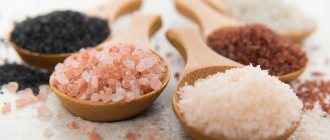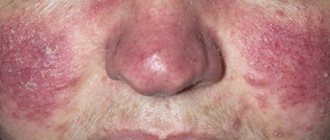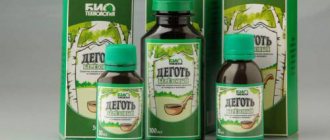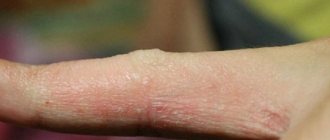For many years, scientists and doctors around the world have emphasized the unsafety of prolonged exposure to the sun without appropriate protective measures.
One of the reasons for the negative attitude towards excess ultraviolet radiation is the possibility of the formation of keratomas on human skin.
Keratoma occurs as a result of uncontrolled growth of the epidermis. During this growth and its later keratinization, a growth is formed on the body, the average size of which varies between one and two centimeters. The tumor visually resembles a raisin.
It is this benign formation that is called a keratoma.
Causes of keratomas
Keratomas most often affect exposed areas of the skin - face, neck, arms.
Less commonly, this disease affects the back or abdomen. This arrangement of growths gives reason to believe that keratosis is caused by excessive exposure to the sun.
These conclusions are confirmed by scientific research.
Aging skin is at greatest risk; it is the skin that is especially sensitive to excess ultraviolet radiation. People over 50 years of age often suffer from keratomas. This disease even received a separate name - “senile warts” .
It is worth emphasizing that this type of wart, unlike other varieties, is not caused by a virus and is not transmitted from person to person in any way.
However, there is a possibility of a genetic predisposition to this disease.
In addition to excess ultraviolet radiation, other possible causes of senile warts should be mentioned:
- Lack of vitamins in the body.
- The prevalence of animal fats in the diet and the lack of plant fats.
- Predisposition to seborrhea.
Skin aging in old age
The main causes of skin aging include:
- Changes at the cellular level. In older people, with age, regeneration processes stop, dying fibers begin to collect between the cells, which makes the skin flabby and inelastic.
- One of the main reasons for the withering of the dermis is impaired blood circulation. A person stops growing after 25 years, accordingly, all processes in the body slow down, and vascular atrophy occurs.
- In old age, the sebaceous glands become less active, which causes dehydration of the skin, thereby making it drier.
- The older we are, the slower metabolic processes occur, and, as a result, this negatively affects the ability of cells to divide.
- Lack of vitamins, poor diet and lack of essential microelements affect skin tone. To maintain the latter, you need to eat more plant foods.
- Abuse of bad habits.
- Age-related changes after 40 years.
With age, the layer of the epidermis decreases, the dermis ages, and the functioning of the sebaceous glands deteriorates. Muscle fibers do not produce the required amount of protein. All these processes lead to the fact that the skin ceases to be moisturized and the amount of mucopolysaccharides decreases.
After 40 years, people experience a noticeable deterioration in the condition of their skin. Wrinkles, loose eyelid skin, more expressive nasolabial folds, pinkish stars, facial hair, and sometimes dark spots - all this indicates a disruption in the functioning of blood vessels.
After 50 years, hormonal changes occur. There is a lack of estrogen, blood circulation and cell division slow down, which contributes to the formation of pigmentation and deterioration of the dermis. There is swelling, deep wrinkles, the skin of the eyelids and face sags, fades and becomes drier and thinner.
Kinds
Senial keratoma
This type of disease is characterized by the appearance of gray-white growths .
Such keratomas are prone to inflammation, they often peel off and bleed.
Such formations appear mainly in people over 30 years of age.
Affected areas are exposed skin: face, neck, forearms.
Seborrheic keratoma
The most dangerous type of keratoma is seborrheic.
During the course of this disease, a yellowish spot on the skin transforms into a dark brown growth.
Such formations are prone to constant itching, peeling, and cracks. Keratomas often fall off, which entails bleeding.
In such cases, there is a need to consult a doctor, since an infection can enter the body through the resulting wound.
Horny keratoma
The so-called cutaneous horn is particularly impressive in size.
These dark brown formations rise several millimeters above the surface of the skin.
The height of such keratomas can reach seven to eight millimeters. Often several such formations appear on the skin at the same time.
It is horny keratomas that most often develop into a malignant tumor . This type of growth requires maximum attention and, possibly, surgical intervention.
Solar keratoma
Ketactinic keratosis is considered a precancerous stage of the disease .
This type of disease is characterized by a large number of foci. The formations are covered with dry grayish scales.
This type of keratoma is especially common among men over forty years of age.
The disease affects areas of the skin most exposed to sunlight. This disease often occurs among summer residents.
This disease is very insidious, as it may not cause concern to the patient or even to the attending physician. Keratosis almost imperceptibly develops from a benign tumor into cancer.
The only way out in this situation is to be extremely attentive to new growths on the skin and timely medical care.
Follicular keratoma
This type of keratoma is quite rare.
It appears in the form of pinkish-brown nodules.
The dimensions of such formations range from one and a half centimeters.
Women are susceptible to keratosis pilaris. Keratomas appear on the head: under the hairline, on the upper lip.
Why do age spots appear?
Age spots often occur after skin exposure to sunlight
Age spots are caused by the body's overproduction of melanin. Melanin is a pigment that gives human skin its characteristic shade.
When the skin is exposed to sunlight, the body produces melanin to protect it from the harmful effects of ultraviolet rays.
The more melanin is produced, the darker the skin becomes.
Age spots appear when excess amounts of melanin accumulate in one area.
Treatment
In order to avoid the development of a benign tumor into cancer, you should consult a doctor at the first symptoms of keratoma. Your doctor will make a diagnosis based on examination and biopsy.
For a benign course of the disease, the following treatment may be prescribed:
- Taking vitamin C in large doses . This method will prevent the formation of new growths, but will not be able to destroy existing ones. Please note that long-term use of ascorbic acid is harmful to the body. It can lead to both stomach diseases and the formation of kidney stones. The duration of taking any medication should be determined by the attending physician.
- Using hormonal ointments to lubricate spots . These drugs eliminate inflammation and slow down metabolic processes in the skin, which in turn reduces the growth of epidermal cells. Be carefull! The period for using these creams is also prescribed by the doctor. Long-term use of hormonal drugs can provoke the development of fungus.
- Elimination of tanning as the main factor in the occurrence of keratomas.
- Enrichment of the diet with vitamins and vegetable fats.
- Reducing stress . In particular, it is recommended to change the type of activity, place of work or position.
- Full sleep.
Removal
In the vast majority of cases, removal of the formations is still recommended.
Indications for the procedure are the following factors:
- Predisposition to cancer. This is determined by the type of keratoma and the results of clinical tests. This information will be clarified by the attending physician.
- Constant peeling, bleeding, ulceration of keratomas.
- Regular mechanical damage to formations. Keratomas often cling to clothing and are damaged during sleep or water procedures.
- For cosmetic purposes. Often, patients themselves express a desire to get rid of keratomas located on the face or other open parts of the body.
- In case of a large number of tumors on the body.
The following methods are used to remove keratomas:
Laser removal of keratoma
This method is considered the most effective at the moment. Removal occurs under the influence of laser beams. This procedure has no contraindications and eliminates the possibility of relapse.
Keratoma removal with nitrogen
Cryodestruction is performed without the use of anesthesia. During the action of liquid nitrogen, the patient may feel a slight burning sensation. The keratoma disappears on its own within a week after the procedure. A small pink spot remains at the site of formation. It disappears within a month.
Radiosurgery
This is a non-contact method of removing keratoma using a special radio knife. This method is especially popular in cosmetology, as it does not damage adjacent tissues and does not leave any scars.
Removal of keratoma by surgical excision
The classic way to remove tumors. It is performed under anesthesia using a regular scalpel. After the operation, a cosmetic suture remains, which must be removed after a few weeks. This method of removing keratomas can lead to the formation of a scar on the skin.
Age-related skin changes: senile pigmentation
Age-related skin pigmentation changes can be temporary or permanent, total or local - such skin color conditions are called dyschromia. We will not touch on freckles as temporary hyperpigmentation, the problem of albinism and vitiligo - there is no answer to these questions yet. We can recommend turning to decorative cosmetics, the diversity of which gives scope for the expression of individuality.
Chloasma are flat, irregularly shaped, often brown or coffee-colored, sometimes terracotta-colored spots, which are popularly called “liver” or “uterine.” Chloasma most often occurs on the skin of the forehead, eyelids, and cheeks, although not necessarily only on the face; their causes are different - these are serious diseases (pathology of the liver, adrenal glands, Addison's disease, pellagra, porphyrin disease), as well as skin injuries and improper use of perfumes and cosmetic procedures, in addition, occupational hazards are often identified among workers, weavers, auto mechanics ( petroleum products, oils, ethers, etc.). In this case, people most often talk about melasma.
Sometimes it is possible to eliminate the manifestations of senile skin pigmentation with the help of preventive creams: “Cucumber Cream with Vitamin E”, “Ray” or “Shield”, exfoliating salicylic acid preparations, long-term rubbing with a 3-6% solution of hydrogen peroxide, lemon juice, white currant , curdled milk, although it should be recognized that there are frequent cases of ineffectiveness of these measures.
Next, you will learn how you can try to get rid of age-related dry skin.
Folk remedies for treating seborrheic warts
There are traditional medicine recipes, the purpose of which is to treat keratosis.
- It is recommended to treat formations on the face with vegetable oil . Sea buckthorn, fir or even sunflower will do. The oil must first be calcined. Carry out the procedure daily. These manipulations will reduce the stiffness of the keratomas.
- Combine baby cream and nut pericarps crushed in a coffee grinder in proportions of five to one . Apply this ointment to the affected areas of the skin.
- The nut is also used in the following recipe . Chopped slightly unripe fruits are poured with heated vegetable oil (temperature - 45°). The proportions are one to six. The mixture should be infused in a thermos for 24 hours. The product is then cooled and filtered. The resulting liquid mass should be rubbed into sore spots for two weeks.
- Bay leaves are used to reduce the growth of tumors and relieve pain . It is mixed with butter in a ratio of one to twelve. Add 12-15 drops of fir or lavender essential oil to one hundred grams of the resulting mass. This remedy is especially useful for older people.
- In precancerous situations, use the following recipe . Crushed dry leaves of celandine are mixed with rendered pork fat. This mixture can only be stored if 10 drops of carbolic acid are added to it.
- It is also recommended to drink various herbal infusions and teas . Plants such as burdock root, St. John's wort, rose hips, and celandine have proven themselves well.
If you use any folk recipes, do not forget that keratomas can develop into cancer! Even such treatment still needs to be agreed upon with a doctor.
Stages of home care
- Wash your face twice a day with cool water, but preferably with gel or foam (with a pH of about 5–5.5): such products preserve the skin’s protective barrier;
- be sure to remove makeup before going to bed;
- use cosmetics that suit your skin type;
- use two different products for day and night care, better moisturizing during the day, nourishing at night;
- pay special attention to the area around the eyes, using special creams and serums labeled “for eyelids”;
- give preference to sunscreen cosmetics using special products (with SPF of at least 30).
Prevention
In order to prevent the appearance of such neoplasms, certain rules should initially be followed. These conditions are similar to all keratosis treatment methods.
- You should not get carried away with tanning . It is necessary to use protective creams and give preference to light-colored clothing. You should not sunbathe at critical times - from 10 am to 4 pm.
- It is necessary to saturate the body with vitamins . Both medications and a varied diet will help here.
- Proper nutrition . Animal fats not only increase cholesterol levels, but also contribute to the development of keratomas.
- A healthy lifestyle will improve immunity, metabolism, and protective functions of the body. Which in turn will prevent the risk of getting sick.
- Reducing the amount of stress will also have an extremely positive effect on your health.
- Adequate sleep is one of the fundamental factors affecting human health.
| Take care of your health and the health of your loved ones. The older generation needs special care and attention. You should not be dismissive of such a seemingly common problem as spots on the skin of older people. Spots noticed and diagnosed in time will not have a chance to turn into cancer. Taking good care of your health will provide you with long and fulfilling years of life! | |










